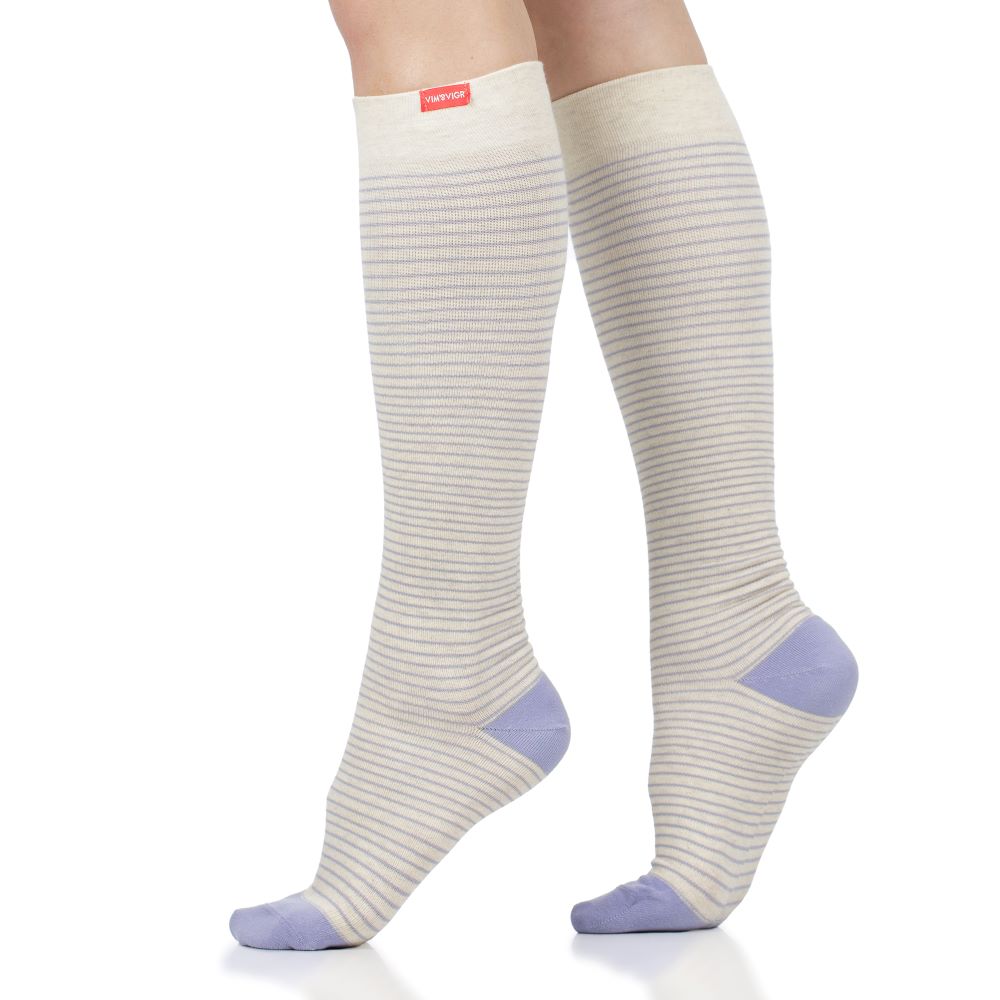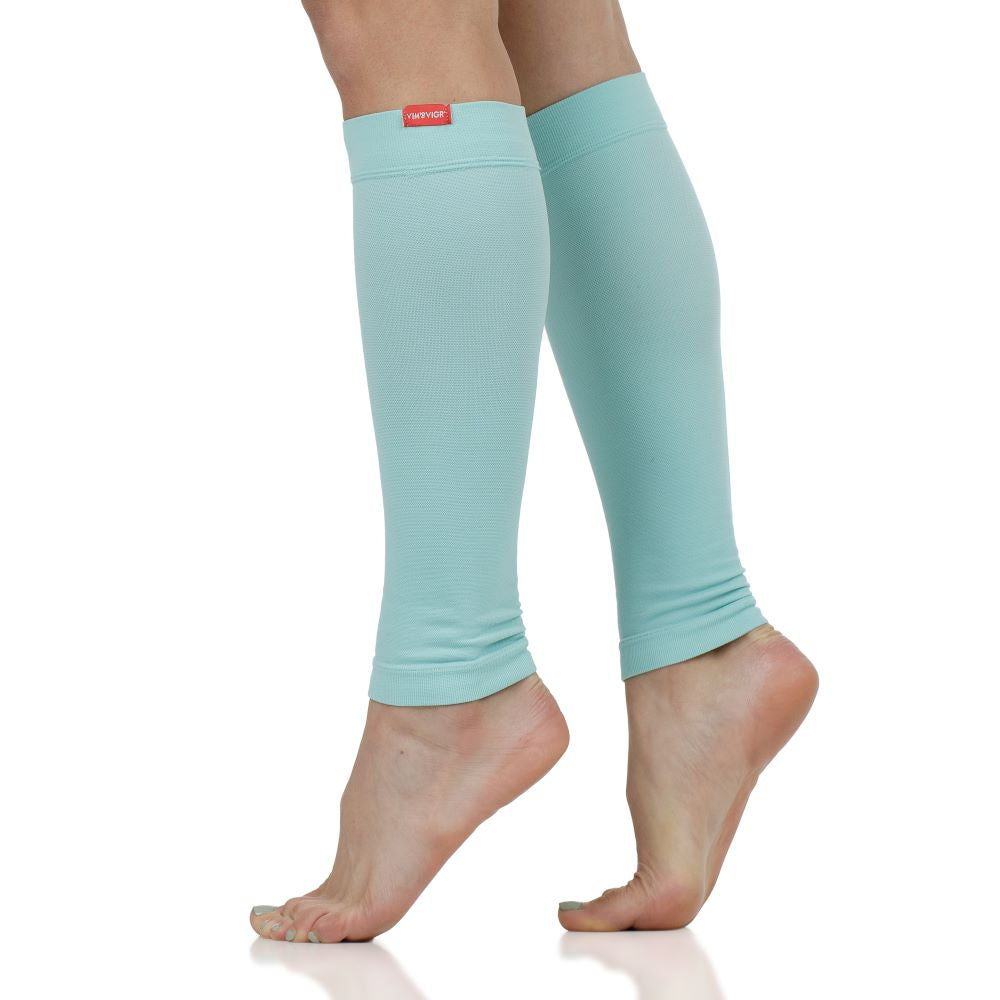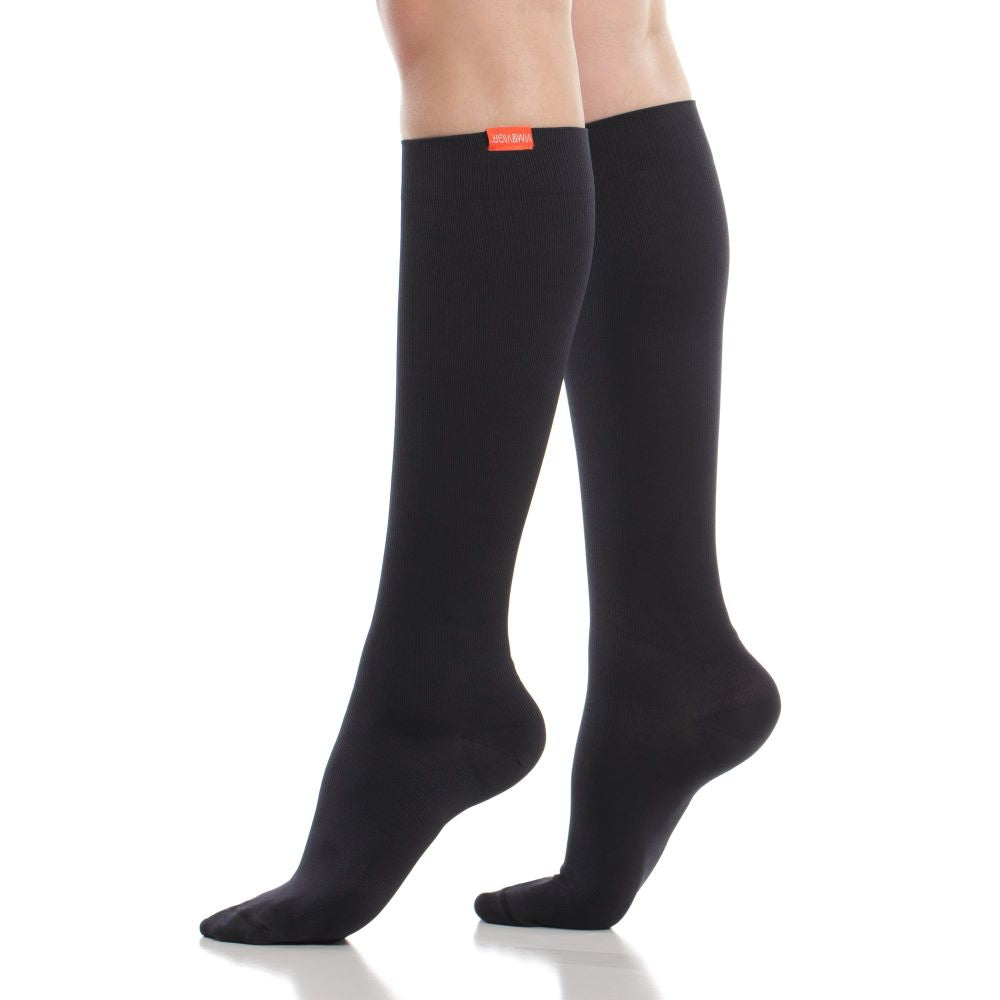Compression Pants vs Leggings vs Tights: What's the Difference?
Scientifically Reviewed by Daniel Chantigian
Compression pants or leggings are designed to apply therapeutic pressure to your legs. They improve circulation and provide better muscle and joint stability. Non-compression tights and leggings are simply tight-fitting, but they do not apply that therapeutic pressure and therefore do not have any health benefit.
In this blog, you will learn the differences between these items and give you our top tips for making a choice that is best for you.
What’s the Difference Between Compression Pants and Leggings?
Leggings or tights (without the “compression” part) are just tight-fitting, lower body garments that can be worn for athletic activities or simply as part of your everyday outfits. Compression pants, more often known as compression tights or leggings, are specifically designed to apply therapeutic pressure to the legs, which soothes your muscles, boosts circulation, and offers extra support while you wear them.
So, it is not just semantics. When you wear casual leggings, your legs will feel supported, since the cut of these garments is tight-fitting. But only compression leggings give you the added benefit of better blood flow, muscle support, and joint stability.
Comparing Compression Pants vs Leggings
Beyond the feeling of tightness that you get with all these items (in varying degrees), there are differences between compression pants and non-compression leggings. Here is all you need to know.
Material and Fabric
Regular leggings and tights may be made from a range of different fabrics, from cotton to polyester and other fabric blends. The focus is not necessarily on providing performance benefits, breathability, or health benefits, but rather just on looks.
Compression tights are usually made from nylon and are designed to work seamlessly with your body as you move. At VIM & VIGR, we offer footless tights which you can wear while working out, or solid full-length tights that go with any outfit, during the daytime or evenings. This material is breathable and sleek to create a feeling of being supported while not affecting your movement. Nylon is also better at wicking away moisture than traditional cotton, which can be comfortable but will retain sweat when you work out. We recommend comfortable, cotton compression socks for recovery after exercise or a long day on your feet.
Fit and Comfort
The terms “tights” and “leggings” are associated with a tight garment fit. It’s the same in the case of compression pants (or compression tights). These garments are all cut to fit tight against your legs, for both aesthetic and functional reasons.
Well-fitting compression pants should feel comfortable and supportive. If you have never worn compression pants before, they may feel a little tight, but you will get used to them after a few wears. You want some pressure on your leg muscles (which is how you get the added support and the benefits to blood flow), but not so much that you’re feeling like your pants are too tight and restrict your movement. It’s the same with regular leggings, only they don’t provide any therapeutic benefits.

Keep your blood flow going with compression tights.
Support and Compression Levels
When you wear casual leggings and tights, you may feel supported because of the tight fit, but these garments are not designed to give you any additional health benefits. You also cannot purchase them in different levels of compression - you just make your choice based on your size.
On the other hand, compression tights are designed to apply gentle pressure on the legs. This therapeutic pressure stimulates blood flow, ensuring that your legs stay energized all day and that you avoid conditions such as blood clots, varicose veins, or deep vein thrombosis. It also gives your muscles added support and soothes aches and pains, all while supporting the joints.
Compression pants can be purchased in different compression levels, measured in mmHg. Pressures are available for casual wear to medical grade that are available by prescription only:
- 15-20 mmHg - everyday wear, gentle compression that stimulates blood flow.
- 20-30 mmHg - firm compression designed for circulatory conditions such as varicose veins and prevention of deep vein thrombosis; usually recommended by a doctor or physical therapist.
- 30-40 mmHg - medical grade compression available only with a prescription; usually for people recovering from surgery, with limited mobility, or for those who suffer from more serious circulatory problems.
Performance Enhancements
Athletes often wear compression stockings, tights, or leggings when playing their sport or recovering after workouts. This is because compression therapy can speed up the time it takes to recover between sessions, thanks to boosting local blood flow and improving nutrient and oxygen supply to the muscles.
But there is more to it. Wearing compression tights while running or walking can improve your joint stability to reduce the impact on your joints and muscles from repeatedly landing on hard surfaces. This means you may feel less fatigue or joint pain during exercise. Additionally, the benefit of feeling more support in the lower legs is welcome, especially if you’re returning from an injury.
Regular tights and leggings do not offer any performance benefits. They can look and feel great when you are working out, and athletic tights designed for sports will usually give you the benefit of being breathable and moisture wicking. However, there is no specific joint support or therapeutic pressure to boost blood flow.

Boost your performance in running compression tights.
Durability and Longevity
High-quality compression tights will last a long time if you care for them and follow instructions on washing and drying them correctly. Our Vim & Vigr compression pants can be machine washed on a delicate cycle with cold water. You should always avoid washing compression gear in hot water, because hot temperatures can harm the materials and reduce the pressure applied to your legs.
We also recommend that compression tights and pants be left to dry naturally and not be put in a dryer. Again, this helps keep the fabric intact and maintain pressure on your limbs when you next wear them.
The durability of non-compression tights and leggings depends on the material and the quality of the garment. It can vary widely, but we would always recommend also washing those items after every wear in a cold wash and letting them air dry to keep them from stretching and to maintain the integrity of the fabric.
Where Do Compression Tights Fit In?
Compression tights are designed to apply pressure to your thighs and calf muscles without causing discomfort, while providing joint support and a boost in blood flow. They are beneficial to those who suffer from circulatory problems, but also to athletes who want to improve their performance and recovery times.
A good pair of compression tights soothes the symptoms of blood flow problems. They can also be worn by those who travel or work on their feet a lot to prevent swelling, pain, and discomfort. Nurses, teachers, or hairdressers can benefit from having a boost to their peripheral circulation to keep blood from pooling around their lower limbs. Compression leggings, tights, or socks can help prevent varicose veins, blood clots, or heavy legs.
What Is the Point of Wearing Compression Pants, Leggings, or Tights?
Wearing compression pants or tights can offer a range of health benefits:
- Improved blood flow and better circulation throughout the body
- Reduced inflammation and swelling
- Reduced risk of blood clots and venous problems
- Increased athletic performance due to better muscle recovery and reduced fatigue
- Lower risk of cramps
- Better support for the joints and muscles
For those who already enjoy the benefits of graduated compression socks, switching to tights gives you more coverage for the whole leg. This improves support for the thighs and pelvic area, while also giving you more outfit options for all-day wear. Finally, compression pants are great under ski or snowboarding clothing for keeping you warm and supported all day long on your winter vacation.
Is It Ok to Wear Compression Pants, Leggings, or Tights All Day?
Yes, you can wear compression garments for as long as you are comfortable, and many people enjoy them for all-day wear. This is both a matter of personal preference and how well your pants or leggings fit you. If you wear good-quality compression pants in the right size and compression level, you should be able to spend the entire day in them without having any discomfort. Most people can wear compression in the 15-20 mmHg range without any issues for hours on end.
If you have any doubts or questions, however, please first consult with a medical professional.
How to Choose the Right Option for You
How you wear your compression pants or leggings is very much up to you. Whether you run, walk, stand around all day, or have a job where you are on your feet a lot, you may get circulatory benefits and feel more supported and soothed in high-quality compression tights.
Use Cases
The most popular use cases for compression clothing include physical activity, pregnancy, travel, recovery from surgery, and jobs where people either sit or stand for an extended period. In all these cases, a boost in lower leg blood flow can make an enormous difference to comfort and long-term health of your circulatory system.
Athletes and people playing sports casually can benefit from better support to the leg muscles and joints during or after exercising. Compression tights apply a gentle pressure throughout the leg, which is reassuring and reduces the impact of running or jumping on the muscles and joints by improving stability. The improvements in stability could reduce your risk of injury, too. Additionally, after exercising, wearing compression pants has been shown by scientific research to improve recovery and soothe aching muscles.
Pregnant women often struggle with lower leg circulation because of the added pressure of gravity and the increase in blood volume in their body. This can lead to blood clots or pressure on the veins, which can cause varicose veins. By wearing graduated compression socks and compression pants, you can release this pressure, reduce inflammation, and boost leg blood flow for better health.
When traveling, we often end up sitting for extended periods of time without enough movement to keep blood flowing in the legs. The CDC advises that this is dangerous for our health, with an increase in the risk of blood clots and DVT for plane passengers. By wearing compression tights, you are reducing these risks and boosting your peripheral circulation. This also keeps down any swelling and inflammation, avoiding that “heavy legs” feeling.
Professionals who are on their feet all day also benefit from the circulation boost given by compression wear. They can avoid sore feet and ankles, swelling, and fatigue, while also staying more energized and comfortable during long shifts.
Lifestyle
Compression pants and leggings are not just for a specific profession or for athletes. In everyday wear, you can pair them with cute outfits for a boost of energy and blood flow in your legs while you meet friends or enjoy a party. Black tights or leggings are ideal for most fall and winter outfits, staying breathable and comfortable in all weather conditions.

Browse our range of compression tights
Personal Preferences
Depending on the circumstances and personal preferences, you may want to reach for compression tights or wear regular leggings in equal measure. Ultimately, it’s important to remember that compression pants give you extra support and the benefit of improving circulation in the limbs. Non-compression tights are also tight-fitting, but they are not designed to apply therapeutic pressure on the legs, so will not benefit your circulatory system.
References
O'Riordan, S. F., Bishop, D. J., Halson, S. L., & Broatch, J. R. (2023). Do Sports Compression Garments Alter Measures of Peripheral Blood Flow? A Systematic Review with Meta-Analysis. Sports medicine (Auckland, N.Z.), 53(2), 481–501. Read it here.
O'Riordan, S. F., Bishop, D. J., Halson, S. L., & Broatch, J. R. (2022). Compression-induced improvements in post-exercise recovery are associated with enhanced blood flow, and are not due to the placebo effect. Scientific reports, 12(1), 16762. Read it here.
Mayrovitz, H. N., & Macdonald, J. M. (2010). Medical compression: effects on pulsatile leg blood flow. International angiology : a journal of the International Union of Angiology, 29(5), 436–441. Read it here.
Sachdeva, A., Dalton, M., & Lees, T. (2018). Graduated compression stockings for prevention of deep vein thrombosis. The Cochrane database of systematic reviews, 11(11), CD001484. Read it here.
Angelakos, I., Mills, C., & O'Halloran, J. (2020). The Effects of Compression Garments on Stability and Lower Limb Kinematics During a Forward Lunge. Journal of human kinetics, 71, 59–68. Read it here.
Sachdeva, A., Dalton, M., & Lees, T. (2018). Graduated compression stockings for prevention of deep vein thrombosis. The Cochrane database of systematic reviews, 11(11), CD001484. Read it here.
Hettchen, M., Glöckler, K., von Stengel, S., Piechele, A., Lötzerich, H., Kohl, M., & Kemmler, W. (2019). Effects of Compression Tights on Recovery Parameters after Exercise Induced Muscle Damage: A Randomized Controlled Crossover Study. Evidence-based complementary and alternative medicine : eCAM, 2019, 5698460. Read it here.
Nickles, M. A., Ennis, W. J., O'Donnell, T. F., Jr, & Altman, I. A. (2023). Compression therapy in peripheral artery disease: a literature review. Journal of wound care, 32(Sup5), S25–S30. Read it here.


















Leave a comment